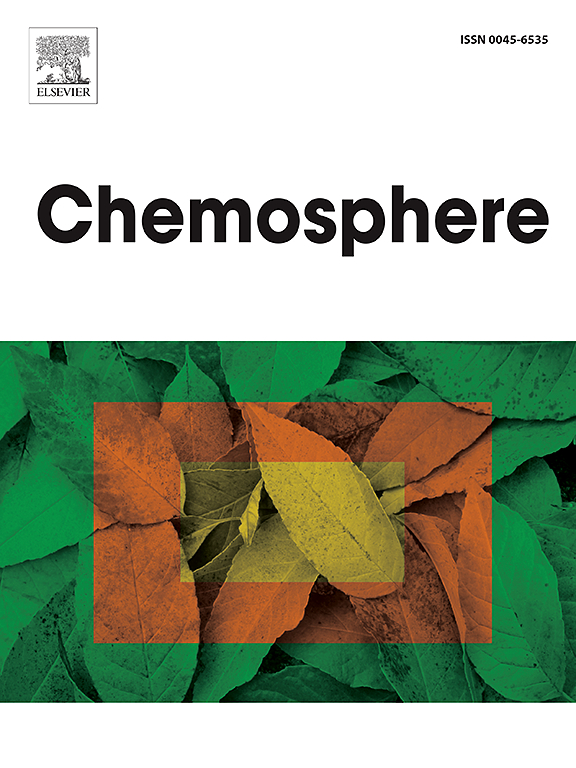Generation, fate and transport of volatile chlorine compounds following hypochlorite discharges to municipal sewers
IF 8.1
2区 环境科学与生态学
Q1 ENVIRONMENTAL SCIENCES
引用次数: 0
Abstract
The presence of volatile chlorine compounds in the headspaces of sewers receiving hypochlorite discharges is of concern because of their potential to cause corrosion of infrastructure and risks associated with human exposures. In the current study their presence was investigated using a commercial gas phase Cl2 sensor. NCl3 was identified as the most likely gas phase species when ammonia is present and it was found that the Cl2 sensor was cross-sensitive to this species. The Cl/N ratio substantially impacted gaseous NCl3 concentrations with maximum values observed at a Cl:N ratio of 12:1. Gaseous NCl3 concentrations decreased as pH increased (6.5–7.5) and temperature decreased (20–15oC). A model that included liquid-gas mass transfer (KLa) and first order decay in liquid (kdl) and gas (kdg) phases was calibrated. The value of kdl decreased as the Cl/N ratio increased (10:1–14:1) but increased as pH and temperature increased. Values of kdl and KLa were lower in real wastewater than in synthetic wastewater. Simulations with a sewer model revealed that with a fixed hypochlorite loading, peak headspace NCl3 concentrations decreased as wastewater flow increased due to changes in Cl/N ratio. Increased air flow reduced headspace NCl3 concentrations immediately downstream of the discharge due to dilution but had little effect further downstream. Wastewater pH impacted headspace NCl3 concentrations by controlling the concentration of NCl3 in the wastewater. Temperature influenced peak headspace concentrations through its impact on mass transfer and gas phase decay rates. This study provides insights that can be employed to develop sewer use bylaws that regulate hypochlorite discharges.

次氯酸盐排放到城市下水道后挥发性氯化合物的产生、命运和运输
在接收次氯酸盐排放的下水道顶部空间中存在挥发性氯化合物令人担忧,因为它们有可能导致基础设施腐蚀和与人类接触相关的风险。在目前的研究中,使用商用气相Cl2传感器调查了它们的存在。当氨存在时,NCl3被确定为最可能的气相物种,并且发现Cl2传感器对该物种交叉敏感。Cl/N比对气态NCl3浓度有显著影响,在Cl:N比为12:1时达到最大值。气态NCl3浓度随pH升高(6.5 ~ 7.5)和温度降低(20 ~ 15℃)而降低。一个包括液气传质(KLa)和液相(kdl)和气相(kdg)一阶衰变的模型被校准。kdl值随着Cl/N比(10:1 ~ 14:1)的增大而减小,但随着pH和温度的升高而增大。真实废水中的kdl和KLa值低于合成废水。下水道模型的模拟表明,在次氯酸盐负荷固定的情况下,由于Cl/N比的变化,峰值顶空NCl3浓度随着废水流量的增加而降低。由于稀释,增加的空气流量降低了排放下游的顶空NCl3浓度,但对下游的影响不大。废水pH值通过控制废水中NCl3的浓度来影响顶空NCl3浓度。温度通过影响传质和气相衰减率来影响峰顶空浓度。本研究提供的见解,可用于制定下水道使用章程,调节次氯酸盐排放。
本文章由计算机程序翻译,如有差异,请以英文原文为准。
求助全文
约1分钟内获得全文
求助全文
来源期刊

Chemosphere
环境科学-环境科学
CiteScore
15.80
自引率
8.00%
发文量
4975
审稿时长
3.4 months
期刊介绍:
Chemosphere, being an international multidisciplinary journal, is dedicated to publishing original communications and review articles on chemicals in the environment. The scope covers a wide range of topics, including the identification, quantification, behavior, fate, toxicology, treatment, and remediation of chemicals in the bio-, hydro-, litho-, and atmosphere, ensuring the broad dissemination of research in this field.
 求助内容:
求助内容: 应助结果提醒方式:
应助结果提醒方式:


